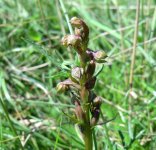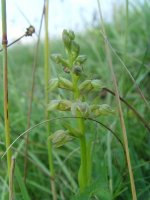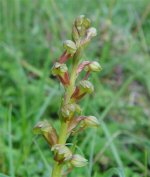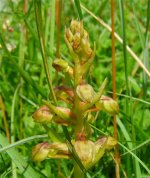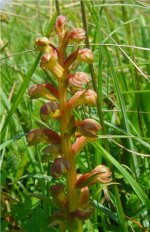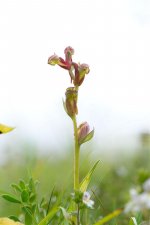-
Welcome to BirdForum, the internet's largest birding community with thousands of members from all over the world. The forums are dedicated to wild birds, birding, binoculars and equipment and all that goes with it.
Please register for an account to take part in the discussions in the forum, post your pictures in the gallery and more.
You are using an out of date browser. It may not display this or other websites correctly.
You should upgrade or use an alternative browser.
You should upgrade or use an alternative browser.
2012 UK Orchid season updates (20 Viewers)
- Thread starter heakl
- Start date
More options
Who Replied?Ghostly Vision
Well-known member
Sorry, everyone, back to the Epipiactis.....
Went to Rich's 2006 site yesterday in the hope of seeing the potential hybrid in the flesh. Unfortunately, the roadside verge/ditch was completely overgrown and overshadowed by sapling Beech, Rowan and other trees and shrubs. As such, only two Broad-leaved helleborines and a single, half-eaten Green-flowered. There is just nowhere for any plants to grow. This may be an artefact of the weather this year, but the invasive vegetation looked well-established, so I suspect the site has had it.
Whilst driving back towards home, spotted a suspicious-looking, sunlit plant on a roadside verge, so stopped to have a look. Found a small colony of Green-flowered helleborine, about 11 plants, plus one, still in tight bud, that appeared to be a Broad-leaved. All of the GFH were in tight bud, or would be of the self-pollinating type, though because of the late season, I'm not sure it's possible to tell yet. Some were quite robust and there was one group of four stems growing out of what was presumably the same rootstock. That is unusual for GFH, I thought. I may be wrong, of course!
Unfortunately, I only had my rubbish camera, and the light was bright sunlight/dappled, so my pictures are awful. However, I've just looked at them and it may be that the four-stemmed plant is a chlorantha/viridiflora Broad-leaved that had not yet opened.
Regards
Sean
Went to Rich's 2006 site yesterday in the hope of seeing the potential hybrid in the flesh. Unfortunately, the roadside verge/ditch was completely overgrown and overshadowed by sapling Beech, Rowan and other trees and shrubs. As such, only two Broad-leaved helleborines and a single, half-eaten Green-flowered. There is just nowhere for any plants to grow. This may be an artefact of the weather this year, but the invasive vegetation looked well-established, so I suspect the site has had it.
Whilst driving back towards home, spotted a suspicious-looking, sunlit plant on a roadside verge, so stopped to have a look. Found a small colony of Green-flowered helleborine, about 11 plants, plus one, still in tight bud, that appeared to be a Broad-leaved. All of the GFH were in tight bud, or would be of the self-pollinating type, though because of the late season, I'm not sure it's possible to tell yet. Some were quite robust and there was one group of four stems growing out of what was presumably the same rootstock. That is unusual for GFH, I thought. I may be wrong, of course!
Unfortunately, I only had my rubbish camera, and the light was bright sunlight/dappled, so my pictures are awful. However, I've just looked at them and it may be that the four-stemmed plant is a chlorantha/viridiflora Broad-leaved that had not yet opened.
Regards
Sean
Out again tonight looking for helleborines. Found a selection but mainly in tight bud. Violet helleborines were growing nicely. Some plants having up to 5 flowering stems growing. Various broadleaved helleborines but with only 1 with open flowers. Finally 15 or so narrow lipped helleborines with again just a single plant in flower. All others looked in tight bud.
Checked the var rosea site I know and there was no sign. It was probalby the same site mentioned previously.
Off for frogs tomorrow!
Ian
Checked the var rosea site I know and there was no sign. It was probalby the same site mentioned previously.
Off for frogs tomorrow!
Ian
Ghostly Vision
Well-known member
Out again tonight looking for helleborines. Found a selection but mainly in tight bud. Violet helleborines were growing nicely. Some plants having up to 5 flowering stems growing. Various broadleaved helleborines but with only 1 with open flowers. Finally 15 or so narrow lipped helleborines with again just a single plant in flower. All others looked in tight bud.
Checked the var rosea site I know and there was no sign. It was probalby the same site mentioned previously.
Off for frogs tomorrow!
Ian
Hi Ian
In which area/county were your Narrlow-lipped?
Sean
Hi Ian
In which area/county were your Narrlow-lipped?
Sean
Buckinghamshire, Chilterns...
rmielcarek
Well-known member
Hot Frogs
Had a few hours out in a very hot Wiltshire and was lucky enough to find a group of about a dozen Frog orchids. Amazing range of colours, and some of the plants were only just starting to flower.
Rich M
Had a few hours out in a very hot Wiltshire and was lucky enough to find a group of about a dozen Frog orchids. Amazing range of colours, and some of the plants were only just starting to flower.
Rich M
Attachments
Northern Wanderings.
First to Holy Island this time last week. Over a dozen spikes of Sancta helleborine and should still be good now. Then down to Killingworth Chuchyard in the north of newcastle. An overgrown, badly cared for site with litter everywhere, but more than a dozen Youngs helleborine ( as they were ) in bud still so maybe starting to flower now. Many dune helleborines with good flower at Close House reserve in Wylam with the fabulous Boathouse pub to quench your thirst on about ten real ales on the other side of the river. You'll need it too, the insects are nasty. Then on to Beltingham the next day, also next to The Tyne, supposed also to be a big dune helleborine reserve but I looked up and down and found two bedraggled plants which looked like they had been ravaged by floods. Maybe the reason for lack of plants this season. Then on to Williamston near Slaggyford (alston) also for dune helleborines. Hundreds of spikes here very easy to find and should be in excellent flower now. But if you thought Close House at Wylam was bad for insects, you will be devoured by midges here so bring some insect repellent, a flame thrower, or spend the afternoon in the local boozer before you get here then you won't feel anything! They are BAAAD! later to Cliburn Moss an NNR SE of Penrith where someone told me there were Creeping Ladies tresses. This place is basically a really, really wet bog. Forget wellies or boots as they will not cut it here, you just have to jump in and get wet. I had vague directions, and searched and searched getting wetter and wetter, sometimes up to the top of my thighs. Suddenly after about 80 minutes I spotted a spiral flower couldn't believe it then about 8 more, all in flower some more than others. Good find. I called the guy at Natural England when i got home to let him know I'd seen some and he proceeded to let me know that my find was like finding a needle in a haystack. And also that you can stay dry and be led to the plants by the ranger at Center parcs at Whinfell Forest a few miles to the north. Aaargh, if I had known at the time.....but far too easy!!! Orton village north of tebay has very wide road verges which are full of hundereds of flower species and many orchids mostly common spots but some marsh evidently, hybrids and fragrants just coming. Waitby greenriggs near Kirkby Stephen an old railway cutting. very nice and very orchid rich. The usual suspects, fragrants just coming into full flower, marsh helleborines and a couple of frogs about to explode into flower which should have more flowers and be taller than I have ever seen on a plant previously. last stop up on Great Asby Scar where I went to photograph the cracked limestone pavement and at about 350 metres found my highest ever orchid just coming into flower. Looks to me like a small flowered common spot, but not another orchid anywhere.
First to Holy Island this time last week. Over a dozen spikes of Sancta helleborine and should still be good now. Then down to Killingworth Chuchyard in the north of newcastle. An overgrown, badly cared for site with litter everywhere, but more than a dozen Youngs helleborine ( as they were ) in bud still so maybe starting to flower now. Many dune helleborines with good flower at Close House reserve in Wylam with the fabulous Boathouse pub to quench your thirst on about ten real ales on the other side of the river. You'll need it too, the insects are nasty. Then on to Beltingham the next day, also next to The Tyne, supposed also to be a big dune helleborine reserve but I looked up and down and found two bedraggled plants which looked like they had been ravaged by floods. Maybe the reason for lack of plants this season. Then on to Williamston near Slaggyford (alston) also for dune helleborines. Hundreds of spikes here very easy to find and should be in excellent flower now. But if you thought Close House at Wylam was bad for insects, you will be devoured by midges here so bring some insect repellent, a flame thrower, or spend the afternoon in the local boozer before you get here then you won't feel anything! They are BAAAD! later to Cliburn Moss an NNR SE of Penrith where someone told me there were Creeping Ladies tresses. This place is basically a really, really wet bog. Forget wellies or boots as they will not cut it here, you just have to jump in and get wet. I had vague directions, and searched and searched getting wetter and wetter, sometimes up to the top of my thighs. Suddenly after about 80 minutes I spotted a spiral flower couldn't believe it then about 8 more, all in flower some more than others. Good find. I called the guy at Natural England when i got home to let him know I'd seen some and he proceeded to let me know that my find was like finding a needle in a haystack. And also that you can stay dry and be led to the plants by the ranger at Center parcs at Whinfell Forest a few miles to the north. Aaargh, if I had known at the time.....but far too easy!!! Orton village north of tebay has very wide road verges which are full of hundereds of flower species and many orchids mostly common spots but some marsh evidently, hybrids and fragrants just coming. Waitby greenriggs near Kirkby Stephen an old railway cutting. very nice and very orchid rich. The usual suspects, fragrants just coming into full flower, marsh helleborines and a couple of frogs about to explode into flower which should have more flowers and be taller than I have ever seen on a plant previously. last stop up on Great Asby Scar where I went to photograph the cracked limestone pavement and at about 350 metres found my highest ever orchid just coming into flower. Looks to me like a small flowered common spot, but not another orchid anywhere.
Mapledurwell fen yesterday. Most s marsh, common spot, hybrids finishing, marsh helleborines still good. marsh fragrants still good some even with tight buds. many nice narrow leaved marsh orchid. Ladle Hill, about 75 burnt tip after a quick count. They seem to have a short life, the flowers in tight bud a couple of weeks ago are on their way out now, but still worth going to see as there are still some nice ones. later for a quick visit to Warburg to see narrow lipped helleborines. About half a dozen plants here still in tight bud although I have seen then in flower by now. I would have thought still a week till a flower will emerge.
Northern Wanderings.
First to Holy Island this time last week. Over a dozen spikes of Sancta helleborine and should still be good now. Then down to Killingworth Chuchyard in the north of newcastle. An overgrown, badly cared for site with litter everywhere, but more than a dozen Youngs helleborine ( as they were ) in bud still so maybe starting to flower now. Many dune helleborines with good flower at Close House reserve in Wylam with the fabulous Boathouse pub to quench your thirst on about ten real ales on the other side of the river. You'll need it too, the insects are nasty. Then on to Beltingham the next day, also next to The Tyne, supposed also to be a big dune helleborine reserve but I looked up and down and found two bedraggled plants which looked like they had been ravaged by floods. Maybe the reason for lack of plants this season. Then on to Williamston near Slaggyford (alston) also for dune helleborines. Hundreds of spikes here very easy to find and should be in excellent flower now. But if you thought Close House at Wylam was bad for insects, you will be devoured by midges here so bring some insect repellent, a flame thrower, or spend the afternoon in the local boozer before you get here then you won't feel anything! They are BAAAD! later to Cliburn Moss an NNR SE of Penrith where someone told me there were Creeping Ladies tresses. This place is basically a really, really wet bog. Forget wellies or boots as they will not cut it here, you just have to jump in and get wet. I had vague directions, and searched and searched getting wetter and wetter, sometimes up to the top of my thighs. Suddenly after about 80 minutes I spotted a spiral flower couldn't believe it then about 8 more, all in flower some more than others. Good find. I called the guy at Natural England when i got home to let him know I'd seen some and he proceeded to let me know that my find was like finding a needle in a haystack. And also that you can stay dry and be led to the plants by the ranger at Center parcs at Whinfell Forest a few miles to the north. Aaargh, if I had known at the time.....but far too easy!!! Orton village north of tebay has very wide road verges which are full of hundereds of flower species and many orchids mostly common spots but some marsh evidently, hybrids and fragrants just coming. Waitby greenriggs near Kirkby Stephen an old railway cutting. very nice and very orchid rich. The usual suspects, fragrants just coming into full flower, marsh helleborines and a couple of frogs about to explode into flower which should have more flowers and be taller than I have ever seen on a plant previously. last stop up on Great Asby Scar where I went to photograph the cracked limestone pavement and at about 350 metres found my highest ever orchid just coming into flower. Looks to me like a small flowered common spot, but not another orchid anywhere.
I'm hoping to try for 'Epipactis sancta in the first full week of August as I am on a family holiday at Langdon Beck near Teesdale & I know I might be a bit too late for them but the wife wants to go to Holy Island so do you have any precise directions for them, it would be much appreciated, this would be my first new Orchid species since 1999 when I saw Creeping Lady's-tresses in Scotland.
Mike.
P.S. Dose anybody know what access is like for Teesdale Sandwort.
hybrids finishing,
Hi,
Whilst you are back on here. Did you refind your Southern Marsh x Marsh Fragrant? I was with the Hants county recorders the other week and mentioned your earlier comments. The site was later checked without success.
As a bit of background the site has never had a record of this hybrid, which has only officially been recorded twice in Hampshire; once in the 1930s, and a well twitched plant in 1981/82. So your plant(s) would be worth recording officially, if you were happy with the id.
Thanks
That reminds me of a Helleborine that I photographed six years ago and identified as Green-flowered but it's bugged me ever since. It was at a site where there are Broad-leaved and a few Green-flowered of the type where the buds only open slightly or not at all.
I've got this thing, which was growing in a storm gutter by the side of a busy road, down as a pendula GFH but I often look at it and have my doub
Anyone any views?
Rich M
Rich emailed me privately about this plant, however I've only just had chance to have a good look at the images
Rich's original idengification is I feel correct. The ovaries are elongated as is often the case with this flavour of phyllanthes, nicely ribbed and are surely glabrous ( E helleborine can of course have glabrous ovaries). Similarly the tepals are somewhat elongated and typically washed out. The anther cap is slightly elongated and stalked , while the column as a whole looks to me more indicative of phyllanthes. The flowers are rather more horizontal and open as is often the case with pendula. Of all the flavours of phyllanthes pendula is the one which perhaps most often exhibits intact pollinia and, not infrequently, a viscidium. The leaf arrangement is a red herring; the plant is growing in an open sunny location and thus doing what Epipactis helleborines tend to do in such circumstances. The presence of ants is irrelevant; I have regularly seen phyllanthes destroyed by ants here in Yorkshire and also along with E dunensis on the Sefton coast. In short there is nothing to me which obviously references E helleborine; at least based on the somewhat limited photographic data available
E phyllanthes is a hugely variable taxon, hence the initial confusion when it was first discovered. It would take an awful lot to convince this committed Epipactophile of the identification of an unusual plant as a hybrid involving phyllanthes
JCL
Well-known member
Mapledurwell fen yesterday. ... marsh helleborines still good.
At Sandwich Bay yesterday, Marsh helleborines near the bird obs almost entirely over; just a handful of plants in acceptable nick. S Marsh well over. Skeletons of lizards, only.
James
Phil Bishop
Well-known member
While butterflying over the last two days I have also been keeping an eye out for orchids.
No trace of any Broad Leaved Helleborines at normally reliable spot in East Herts. The area seems to have been flooded and is now very overgrown, and there seem to be a lot of deer in the area.
About a dozen Frogs found in the Aston Rowant area. All very small, less than two inches high and extremely hard to locate. Some very nice colourful ones, including this one
No trace of any Broad Leaved Helleborines at normally reliable spot in East Herts. The area seems to have been flooded and is now very overgrown, and there seem to be a lot of deer in the area.
About a dozen Frogs found in the Aston Rowant area. All very small, less than two inches high and extremely hard to locate. Some very nice colourful ones, including this one
Attachments
Ghostly Vision
Well-known member
Hi Mark,
All very good points. Two things I would note and be interested in your thoughts.....
My experience of probably 15-20 colonies of phyllanthes is, that whilst it is a very variable taxon across the spectrum, within individual populations they are very invariable.
If you are in agreement with this, it does not explain why in Rich's Hampshire colony all plants were cleistogamous except this single one, which has wide open flowers. And shows other anomalous features, such as viscidia -which presumably the rest of the plants wouldn't need, being cleistogamous?
For me, while infraspecific variation can explain a lot of unusual plants, in this case the combination of unusual features in a single plant within an otherwise homogenous colony would set alarm bells ringing.
Cheers
Sean
All very good points. Two things I would note and be interested in your thoughts.....
My experience of probably 15-20 colonies of phyllanthes is, that whilst it is a very variable taxon across the spectrum, within individual populations they are very invariable.
If you are in agreement with this, it does not explain why in Rich's Hampshire colony all plants were cleistogamous except this single one, which has wide open flowers. And shows other anomalous features, such as viscidia -which presumably the rest of the plants wouldn't need, being cleistogamous?
For me, while infraspecific variation can explain a lot of unusual plants, in this case the combination of unusual features in a single plant within an otherwise homogenous colony would set alarm bells ringing.
Cheers
Sean
Rich emailed me privately about this plant, however I've only just had chance to have a good look at the images
Rich's original idengification is I feel correct. The ovaries are elongated as is often the case with this flavour of phyllanthes, nicely ribbed and are surely glabrous ( E helleborine can of course have glabrous ovaries). Similarly the tepals are somewhat elongated and typically washed out. The anther cap is slightly elongated and stalked , while the column as a whole looks to me more indicative of phyllanthes. The flowers are rather more horizontal and open as is often the case with pendula. Of all the flavours of phyllanthes pendula is the one which perhaps most often exhibits intact pollinia and, not infrequently, a viscidium. The leaf arrangement is a red herring; the plant is growing in an open sunny location and thus doing what Epipactis helleborines tend to do in such circumstances. The presence of ants is irrelevant; I have regularly seen phyllanthes destroyed by ants here in Yorkshire and also along with E dunensis on the Sefton coast. In short there is nothing to me which obviously references E helleborine; at least based on the somewhat limited photographic data available
E phyllanthes is a hugely variable taxon, hence the initial confusion when it was first discovered. It would take an awful lot to convince this committed Epipactophile of the identification of an unusual plant as a hybrid involving phyllanthes
Ghostly Vision
Well-known member
Visited three leptochila sites on Friday, in South Wales and Gloucestershire.
Pretty much every plant was in tight bud. They'll need at least a week.Numbers of plants are also about 1/3 of normal levels.
A phyllanthes site in the midlands had a mere two plants, also in tight bud. This site is prone to flooding as it is by a stream, and recent rains had clearly deluged the woodland floor and cast large amounts of debris on the ground. Also, the understorey was getting thick and luch, drowning out the plants. Not looking good for this site, which had up to 30 plants in recent years.
We found Yellow bird's-nest a two of the sites - a nice surprise! This is of course a Ghost Orchid indicator species, so maybe this year there is a chance! Will be checking the Chilterns on Tuesday.
Sean
Pretty much every plant was in tight bud. They'll need at least a week.Numbers of plants are also about 1/3 of normal levels.
A phyllanthes site in the midlands had a mere two plants, also in tight bud. This site is prone to flooding as it is by a stream, and recent rains had clearly deluged the woodland floor and cast large amounts of debris on the ground. Also, the understorey was getting thick and luch, drowning out the plants. Not looking good for this site, which had up to 30 plants in recent years.
We found Yellow bird's-nest a two of the sites - a nice surprise! This is of course a Ghost Orchid indicator species, so maybe this year there is a chance! Will be checking the Chilterns on Tuesday.
Sean
JTweedie
Well-known member
Is it worth reporting orchids when found in urban environments? I'm in the south of Glasgow and noticed from the bus last week that some orchids were on some ground that were formerly the gardens of council flats that were demolished several years ago. Now the land is just wasteland and hasn't been touched or the grass cut since the flats disappeared.
They appeared from my brief view to be heath spotted, so not uncommon, but just wondering if this is the kind of thing local wildlife groups or the council should be aware of?
They appeared from my brief view to be heath spotted, so not uncommon, but just wondering if this is the kind of thing local wildlife groups or the council should be aware of?
Is it worth reporting orchids when found in urban environments? I'm in the south of Glasgow and noticed from the bus last week that some orchids were on some ground that were formerly the gardens of council flats that were demolished several years ago. Now the land is just wasteland and hasn't been touched or the grass cut since the flats disappeared.
They appeared from my brief view to be heath spotted, so not uncommon, but just wondering if this is the kind of thing local wildlife groups or the council should be aware of?
Hi,
Yes, from the point of view of the records office it is always worth sending in a record if you are confident in the identification.
For Glasgow a records form from the Biological Records Centre can be downloaded here:
http://www.glasgowlife.org.uk/museums/projects/Wild About Glasgow/Pages/default.aspx
You may want to check your Orchids arent Common Spotted or a hybrid, rather than Heath Spotted, the former are more usual for an urban environment.
Plus it sounds like the sort of Brownfield site that will end up being redeveloped. A record from yourself or elsewhere may be enough in the planning process to have the value of this population considered in any future planning alongside other issues such as urban regeneration, open space and landscaping.
Cheers
Last edited:
Users who are viewing this thread
Total: 21 (members: 0, guests: 21)




